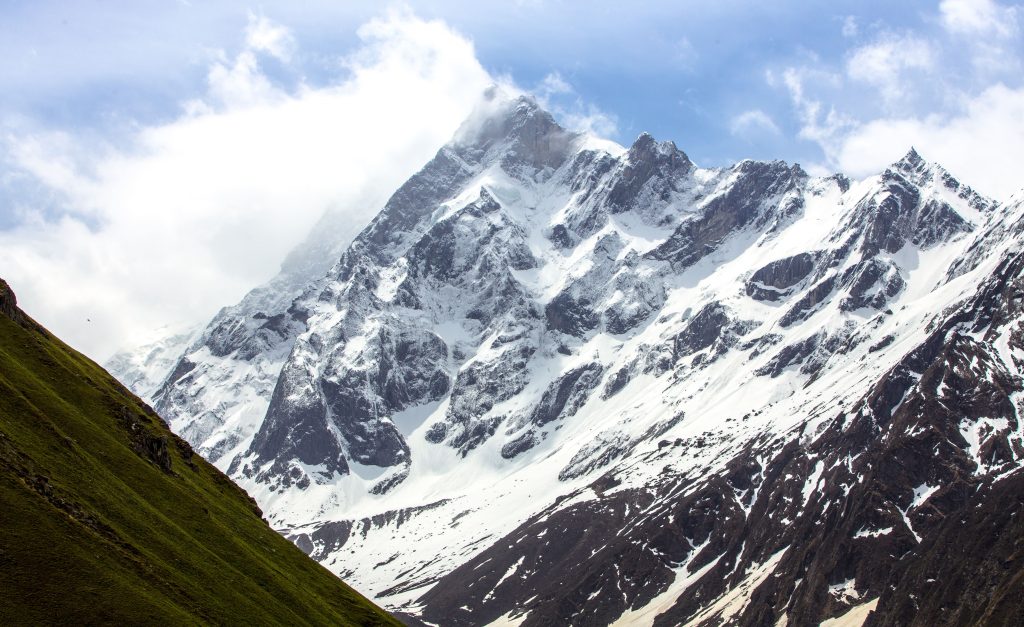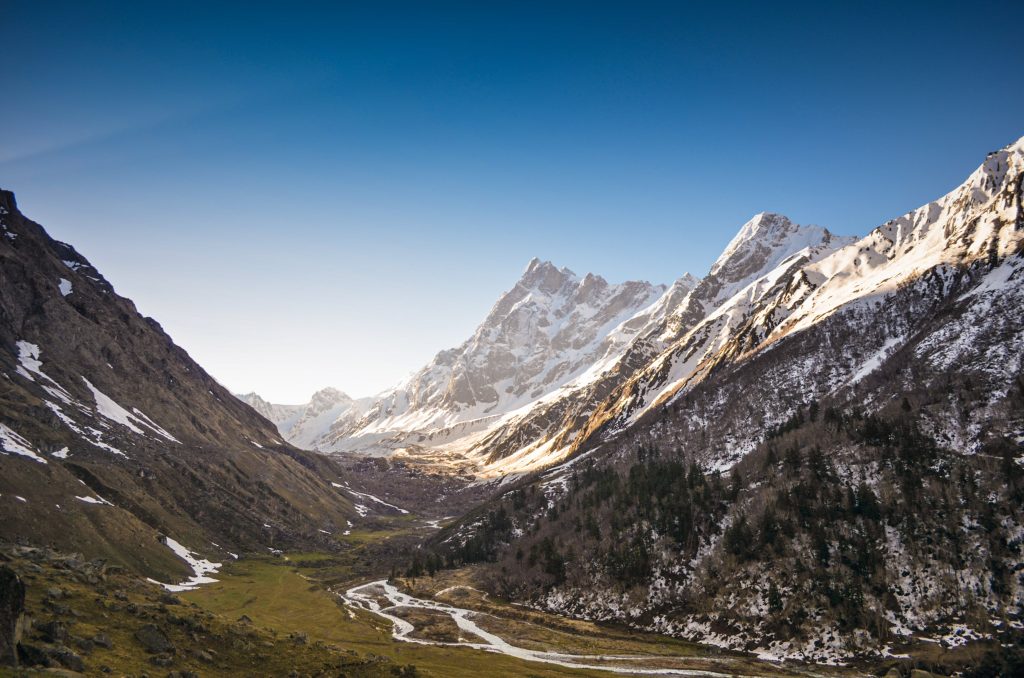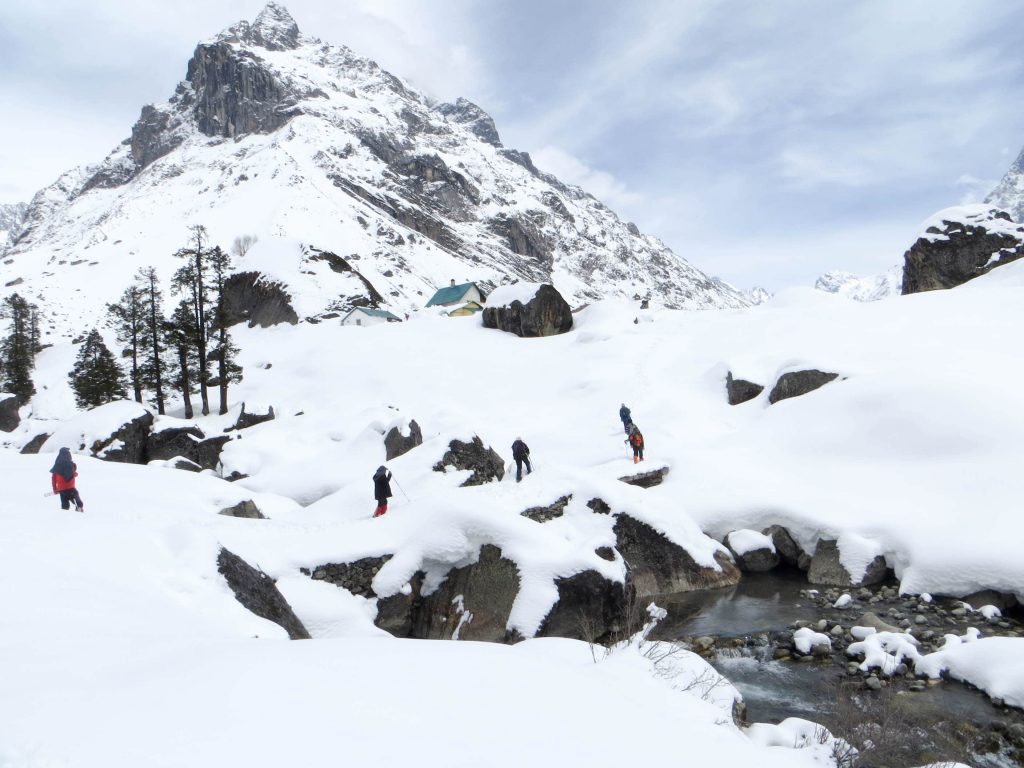There are innumerable treks in Uttarakhand, and the Har ki dun trek is an unusual one that stands out as the kind of adventure that you should try at least once in your life. Har ki dun literally translates to “valley of God,” and its inhabitants adhere to a number of myths and legends. It has a total height of 3,556 metres and is situated at the foot of the imposing summit of Fateh Parvat. This cradle-shaped valley known as Har ki Dun is home to a range of exciting activities, such as bird watching, hiking, and camping.
The location is filled with beautiful Himalayan flora, and the valley is teeming with a variety of exciting animals. It is the principal tributary that contributes to the Yamuna River and is connected to the Baspa Valley by way of the Borasu pass. People from all over the world embark on this hike each year in order to get a glimpse of the breathtaking scenery, tranquil atmosphere, and alluring vegetation that the valley has to offer.

Har ki dun Trek distance
One of the most stunning hikes, known as Har ki Dun, is at an altitude of 3,600 metres. Har Ki Dun is a trek that takes between seven and ten days to complete. It begins from the Sankri base camp and it takes 47 kilometres to reach the Har Ki Dun mountain pass.
The trip from Mussoorie to Sankri takes approximately ten hours. Once you reach Sankri, the hike officially begins at the base camp. Once your trip has begun, your first destination will be Pauni Garaat, and the path you take to get there will take you via Taluka, a tranquil and gorgeous location rich in Kamauni cultures. After leaving Pauni Garaat, the hike continues in the direction of Kalkattiyadhar. The distance between Kalkattiyadar and Har ki dun is only 10 kilometres, yet getting there will take you five hours. When you are making your way back, you will pass through yet another Himalayan village known as Osla before arriving at Sankri and then Mussoorie.

Attractions that will leave you captivated during your Har ki dun trek
Dehradun – one of the oldest towns in India, which is situated between the Ganges and the Yamuna rivers. With its huge cantonments area, it is recognised as one of the most desirable locations for retirement. The city’s bold weather and attractive scenery have resulted in a significant increase in the number of tourists who visit there.
Sankri– Sankri is a quaint community that is home to a few different commercial areas and is known for its breathtaking panorama of the Himalayas. The climb to Har ki Dun begins in a varied landscape of Himalayan trees at this base camp.
One of the holy locations in Sankri that plays host to annual celebrations and fairs is the Someshwar Mahadev temple. The fact that this pahadi-style architecture temple features art made entirely of wood carved from deodars is what sets it apart from others of its kind. The temple dates back to the time of the Pandavas, and it offers a beautiful view of the Swargrohini peaks.
Taluka is a charming settlement that you will come across on the route to Har Ki Dun. Situated at an elevation of 2075 metres, it offers breathtaking vistas of the surrounding valley, and meandering streams run through the verdant marshlands.
A guesthouse run by the Garhwal Mandal Vikas Nigam (G.M.V.M.), which provides lodging for hikers and is managed by the government, can be found in the village.
Osla: Osla is a secluded village located in the Mori Tehsil of the Uttarkashi District. The panoramic views of the surrounding mountains from this exquisite house are truly breathtaking. Your senses will be captivated by the picturesque meadows and peaks, as well as the uncommon flowers that decorate the verdant fields.
A temple for Duryodhana is built in this village. In some parts of the Indian states, locals worship Duryodhana. The temple has a historical story behind it, making the locals worship Duryodhana.
It is said that when Duryodhana died at Kurukshetra, the locals shed tears which formed the river Tamas; hence the water from the river is not for drinking.

Har ki dun:
Situated at the foothills of Swargarohini peak, Har ki dun is one of the most popular trekking gateways in the Uttarakhand region. Har ki dun is a cradle-shaped valley in the Garhwal district with scenic views of nature’s bounty. It is home to the captivating Jaundhar glacier, where nature’s splendour enthrals every visitor. The Har Ki Dun is known as the “hanging valley of gods,” and there is a good chance of seeing wildlife there. While hiking through terraced mountain fields, conifer forests, and lush green grasslands, the scent of pine and the sight of deodar trees will entice your senses.
The Best time to visit Har ki dun
Every beautiful place has the best time, and the best time to plan your Har ki dun Trek is between April to June and September to December. However, if you want to experience snow and go snow trekking, you need to visit in February and March.
As the climate at Har ki dun is not something, you experience daily, ensure adequate time acclimating to the high altitudes.
Har ki dun during summers
During the summer, the weather is nice, which makes trekking a very comfortable experience. The temperature could drop to -1 C, so even in the summer, make sure to bring warm clothes.
Monsoon
Plan your trip to Har ki Dun outside of the monsoon season, when the trail is likely to be blocked by landslides and even the roads are closed. So going to this place during the rainy season can be a little risky.
Winters
The winters at Har Ki Dun Valley are absolutely breathtaking. Snowfall is common throughout the region throughout the winter months. However, the journey will become more challenging as there will be fewer options available for overnight stays. Bring along warm clothing such jackets, raincoats, fleece jackets, thermals, and other similar items. The temperature during this time ranges from -15 degrees Celsius down to 10 degrees Celsius.
Har ki dun trek difficulty level
The Trek ranges from easy to moderate in terms of difficulty. It has a beautiful view that is great for both first-time trekkers and those who have done it before.
If this trek is on your list of things to do, but you’re worried about how fit you are, all you have to do is add walks and cardio to your daily routine a few days before you go on this trip. This is because you will get used to walking, so your body won’t get tired as quickly.

Things you need to carry for your Har ki dun Trek
Clothing and Gear equipments
- A fleece Sweater
- At Least 9-10 quick drying t shirts
- 2-3 long sleeve t-shirt to wear on the short ones or arm sleeves
- 2-3 Cotton t shirts
- 10-12 underpants (4/5 sports bras for women- Sports bra will be a better choice when it comes to comfort)
- A wind cheater or a Poncho
- Raincoat
- Thermal pant and t-shirts ( 2 should be enough)
- 3-4 Trek pants
- Cap and woollen gloves
- Fleece buffs
- Trekking shoes
- 3-4 pairs of woollen socks
- Flip-flops or slip ons for when you are not trekking
- Polaroid Goggles – 3 with categories
- Night wear (2-3 pairs should be enough)
- Knee braces if you have even a bit of knee trouble
- Woollen beanie or a monkey cap
- Casual wear during your travel and sightseeing
Layering up is very important during your trek. Try to wear at least 2-3 layers of clothing in general and a minimum of four layers at higher altitude to keep your warm and protected.
Things to carry in your Toilet Bag
- Toothbrush and toothpaste
- Shampoo
- Face Wash and wet wipes
- Sunscreen with SPF 50+
- Lip balm with SPF 30+
- Quick dry towels
- Band aids
- Pain relief balm
- Medicines for AMS ( Trek nomads carry their own first aid kit anyway)
- Paracetamol and Electral/ORS packets
- ONLY biodegradable pads for the ladies.
Essential Travel Electronics you need to carry
- Power bank
- Phone
- Camera +respective lenses with extra batteries
- An e- reader or a Booklight
- Chargers and Cables
- Headlight
- Electronics organiser bags
Your Daily trek bags for Har ki dun
Following are some essential items that you should keep along with you all the time
- Energy bars
- 2l of water
- Water purification tablets
- Raincoat or a Poncho
- Jacket
Itinerary for your Har ki dun Trek
- Day 1: Arrive at Mussoorie
- Day 2: Travel from Mussoorie to Sankri
- DAY 3: Travel from Sankri to Taluka and Trek to Osla
- DAY 4: Trek from Osla to Har ki Dun base camp
- Day5: Trek from base camp to Har ki dun- Jaundhar Glacier/Hata valley & back to base camp
- Day 6: Trek to Osla from Har ki dun base camp
- Day7: Trek from Osla to Taluka & travel to Sankri
- Day 8: Travel from Sankri to Mussoorie
- Day 9: Travel back home
For detailed itinerary, visit TrekNomads’ official website https://www.treknomads.com/har-ki-dun

Things to remember before your trek
- Consult your physician before embarking on this journey. They will prescribe medications that must be taken if you fall ill during your trip.
- Carry all emergency contact numbers with you for Uttrakhand.
- Carry a sturdy, comfortable, and durable sleeping bag. Carry a durable backpack that can withstand wear and tear, and make sure it has a watertight cover to protect your possessions.
- To prevent frostbite, use proper high-quality footwear. Wear the right socks for blood circulation and carry extra pairs.
- Take care of yourself and be kind to your fellow trekkers, and you will leave Har ki dun with the nicest memories.
- Never leave your teammates and always stick with the group
- To enjoy this hike, refrain from smoking and consuming alcohol and other intoxicants.
The stunning natural scenery of the Himalayas will leave you speechless and in wonder when you complete the trip to Har ki Dun. Have a good time on this hike, and cherish it as an exciting and rewarding experience when you look back.

Why Treknomads
Treknomads was started in 2016 in Bangalore for the small community that loves to explore and adore nature. From multi-day high-altitude Himalayan treks to one-day treks around Bangalore and two-day treks in Western ghats, they are still exploring newer trek trails for nature enthusiasts.
Their philosophy is to help people explore the abundant beauty that nature has to offer through trekking. The best thing about Treknomads is that your Himalayan treks are covered with insurance. To learn more about Treknomads, visit here.
Related blogs:
How to get fit for the himalayan trek
Winter Trekking is Back! All You Need to Know!
Travel Photography Tips A Complete Guide
